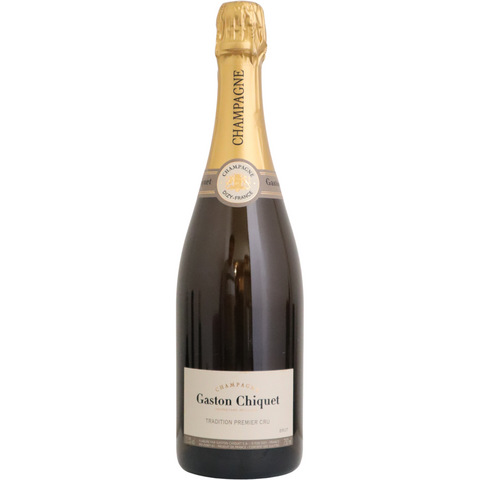
NV Gaston Chiquet 1er Cru "Tradition", Brut, Champagne, France
Elegant and expressive, the NV “Tradition” Brut from Gaston Chiquet delivers a finely tuned balance of orchard fruit purity, creamy texture, and vibrant minerality. Aromas of golden apple, pear, toasted brioche, and almond unfold on a fresh, structured palate that finishes with citrus zest and chalky precision. A Champagne that embodies both charm and character, it offers remarkable depth for a non-vintage cuvée.
There are 152 units left in stock.
ABOUT THIS WINE
The “Tradition” Brut is a multi-vintage blend composed predominantly of Pinot Meunier (40%), with Chardonnay (35%) and Pinot Noir (25%), sourced entirely from Premier Cru vineyards in the Vallée de la Marne, primarily around Dizy. These diverse sites, planted on limestone and clay soils, lend both richness and finesse to the cuvée. Pinot Meunier brings suppleness and fruit, Chardonnay adds lift and elegance, and Pinot Noir contributes structure.
Gaston Chiquet’s NV Brut is crafted using the traditional méthode champenoise, with primary fermentation in stainless steel and extended lees aging—typically three years or more—before disgorgement. The dosage is modest (around 8g/L), allowing the wine’s natural balance and terroir expression to shine. Expect notes of fresh Mirabelle plum, lemon curd, hazelnut, and subtle pastry, framed by a fine, persistent mousse and a saline finish.
This Champagne is both vibrant enough for aperitif service and versatile enough to pair with dishes like seafood tartare, poultry in cream sauce, or aged Comté.
ABOUT THIS PRODUCER
Gaston Chiquet is a historic grower-producer in Champagne, with family roots in Dizy dating back to 1746. As part of the original group of récoltants-manipulants (growers who bottle their own Champagne), the Chiquet family helped pioneer the grower Champagne movement, prioritizing estate-grown fruit and traditional winemaking methods over mass production.
Today, the house farms around 23 hectares, all classified as Premier or Grand Cru, including holdings in Hautvillers, Mareuil-sur-Aÿ, and Aÿ. Committed to sustainable viticulture, Gaston Chiquet uses minimal herbicides, favors cover cropping, and harvests entirely by hand to preserve grape integrity.
The house style is defined by clarity, freshness, and finesse, with each cuvée reflecting the family’s dedication to precision and respect for their unique terroirs. Gaston Chiquet remains a reference point for Champagne lovers seeking depth, authenticity, and grower integrity in every glass.
Details:
| Grape(s) | Pinot Meunier, Chardonnay, Pinot Noir |
| Farming | Sustainable |
